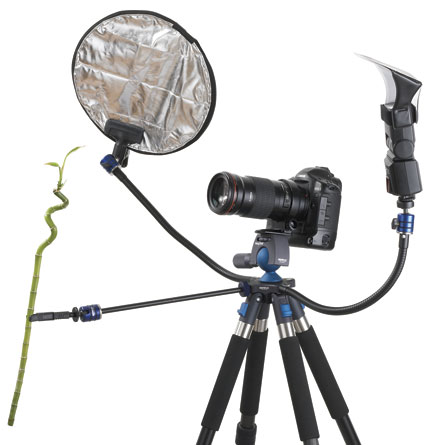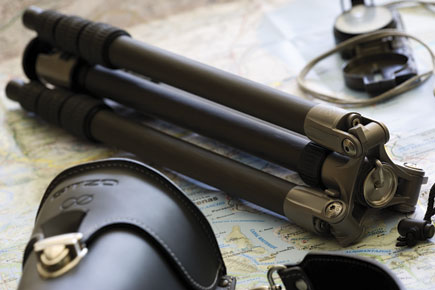Shutterbug’s Exclusive photokina Coverage; Tripods And Camera Supports: A Sampler Of A Prolific Field
At photokina 2008, there was (as usual) an extraordinary range of camera supports. So many in fact that a “laundry list” of new introductions could easily fill the whole magazine. This prompted me to think hard about what to look for in a camera support. It seemed to me there are three things: three legs, if you like. What you need; what you want; and what you can afford. You may care to add a fourth: what you can carry.
The basic requirement, obviously, is something that holds the camera steady, before and during the exposure. There are countless ways of doing that, including just resting it on a table or wall. But there isn’t always a table or wall handy, and even if there is, it may be hard to orient the camera the way you want.
Enter The Pod. Not mono- or tri- or even quadro-; just The Pod, a sort of high-tech beanbag with a camera mount on it. The new Pro Silver Pod has an off-center mount, much better for cameras with long, heavy lenses.
Now grow one leg. Monopods are commonplace, but there was one complete novelty, the Kaiser QuickPod DSLR. It is equipped with a mirror so you can hold it up in the air and see what you are photographing, or use it to take a self-portrait. It’s very light (it has to be if you are holding it at arm‘s length), and it has three vestigial legs that retract into the bottom. As of the end of photokina none of the usual Kaiser distributors had taken it up.
Sticking with monopods, several manufacturers offered tripods where you can remove one leg and use it as a monopod, leaving you with a bipod, and although there were no new bipods at this show, they have been seen in the past: they offer more stability (but also more bulk and weight) than a monopod, and they can be worth considering, e.g., for use in crowds where space is at a premium. Then there was the QuadroPod from Novoflex, where you can remove one leg for a monopod, and still have a tripod…
Ah, yes, the QuadroPod. Have you ever considered a four-legged friend to hold your camera? Novoflex makes one. Or is it two? Or three? These are not the woof, woof kind, but a modular system consisting of three different tops (bosses, spiders, yokes—in German, “Basis”) into which you can screw a choice of legs. The boss of the basic model (QPB) is square, with no center column. The QPC is the same shape, but you can add a center column. The QPV (the Big Boss?) is shaped like a bicycle saddle and can take three legs or four. The interchangeable legs screw in via a 1⁄4” thread.
For a tabletop version you can buy single-section (fixed length) legs, or for a normal-size version you have a choice of three-section or four-section legs in either aluminum or carbon fiber. The center column is optional, as are clips and clamps, suction leg ends, and ground spikes. The range of possibilities is dizzying: three legs, four legs, three legs plus a monopod, with or without the center column… You can buy all the bits separately, and build what you want, or buy a kit for a particular pattern. The engineers at Novoflex argue that the four-legged configuration is more stable than the classic three-leg tripod, and certainly QuadroPods have a very impressive load-carrying capacity at 55 kilos (110 lbs).
 |
|
|
What about more conventional tripods, though? As already indicated, there is more choice than ever, and when it comes to “need” and “want,” though alas not “afford,” the hit of the show for me was Gitzo’s new limited edition titanium-boss Traveler. This is the design where the legs fold up through 180? around the center column, making it much smaller when folded than most tripods with the same maximum height. The titanium boss loses only a few ounces compared with the light-alloy boss, but if you’re going for the best, this is the best of the best. Gitzo is distributed in the US by Bogen Imaging, Inc.
 |
|
|
Actually, Benro had a prototype tripod of a similar design to the Traveler (carbon fiber/light alloy), the Travel Angel, and it will of course be a good deal more affordable than the Gitzo. On the other hand, you can see where the money goes in the fit and finish of the Gitzo. I want the Gitzo a lot more, but I expect to be able to afford the Benro a lot more easily. Benro was talking to an American distributor, but there was no definite news by the end of the show. Check their website for distribution at www.benro.cn.
Another tripod from Gitzo that I want, but don’t really need (and can’t easily afford) is the Ocean, with its polished stainless steel boss and special leg seals (in bright blue!). It was designed to be highly resistant to sand and saltwater.
“Need” and “want” are also affected by what sort of photography you do. I travel a lot, so light weight and compactness are important to me, so I really like the Traveler. A more economical (light alloy) lightweight tripod would be one of the new SPRINT series from SLIK (imported by THK Photo Products), which I also saw and admired. But if you wanted a studio tripod, your needs would be quite different.
Likewise, I am not very strong, so I need easy-to-use leg locks. My old alloy-leg Gitzo Reporter is around 30 years old, but I’d like the new “replica” model of substantially the same tripod. Why? It has the new, much easier to use, G-Loc leg locks. If you have the proverbial iron handshake, this may not matter to you. The new tripod is part of their vintage collection, not a limited edition, and they even offer a leather-bound canvas case for it, complete with their original logo.
Staying with leg locks, Giottos tripods from HP Marketing Corp. now have new Flip-Lock leg locks on both aluminum and carbon-fiber tripods. A general trend seems to be to design the locks so you can grip all of them at once, with one hand, and unlock all the sections of one leg at once: an obvious time saver.
Another design feature that makes tripods easier to use, especially if you have to carry them outside the studio, is hand protection/padding, commonly referred to as “leg warmers.” Closed cell foam is the usual material, but Olivon’s new GC-series uses cork, which is handsome, effective, and sustainable.
Returning to leg materials, carbon fiber offers the best combination of strength, lightness, and “deadness” (vibration absorption)—at a price. Even then, there are different grades of carbon-fiber tripod leg: the spun variety is lighter, stronger, and more expensive than rolled and formed.
Either way, more and more manufacturers are offering carbon-fiber versions of their existing lines, or new designs: Benro, Cullmann (imported by RTS), Davis & Sanford (Tiffen), Gitzo, Induro, Olivon (their newest offering has a combination of carbon and basalt fibers), Manfrotto (Bogen Imaging, Inc., with their 55 series and their ProB 190 series), SLIK, Sunpak (imported by ToCAD), and Vanguard, as well as new models from OEM manufacturers.
 |
|
|
- Log in or register to post comments

































